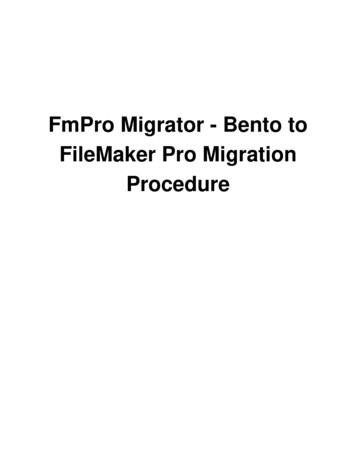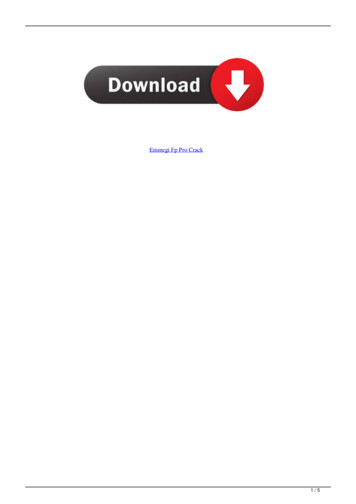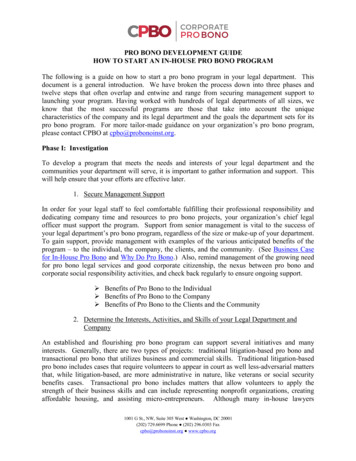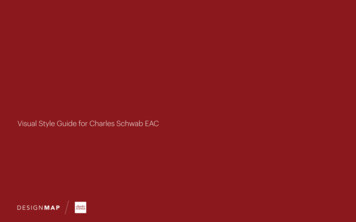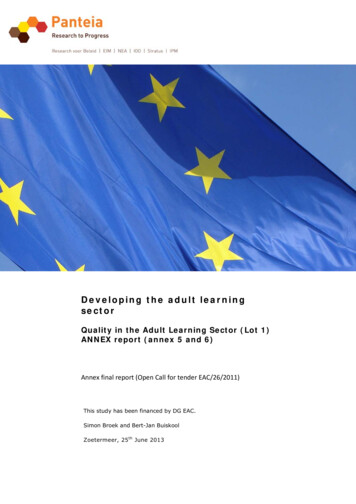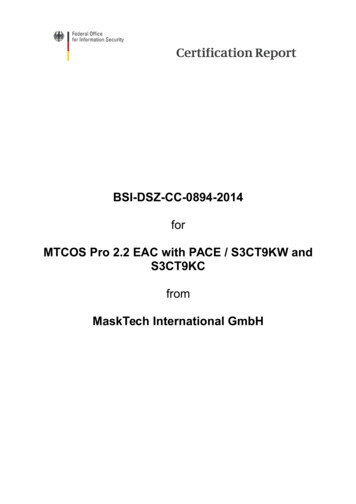
Transcription
BSI-DSZ-CC-0894-2014forMTCOS Pro 2.2 EAC with PACE / S3CT9KW andS3CT9KCfromMaskTech International GmbH
BSI - Bundesamt für Sicherheit in der Informationstechnik, Postfach 20 03 63, D-53133 BonnPhone 49 (0)228 99 9582-0, Fax 49 (0)228 9582-5477, Infoline 49 (0)228 99 9582-111Certification Report V1.0CC-Zert-327 V5.02
BSI-DSZ-CC-0894-2014Security IC with MRTD EAC/PACE ApplicationMTCOS Pro 2.2 EAC with PACE / S3CT9KW and S3CT9KCfromMaskTech International GmbHPP Conformance:Machine Readable Travel Document with "ICAOApplication" Extended Access Control, Version 1.3,10 February 2012, BSI-CC-PP-0056-V2-2012Functionality:PP conformantCommon Criteria Part 2 extendedAssurance:Common Criteria Part 3 conformantEAL 4 augmented by ALC DVS.2, ATE DPT.2 andAVA VAN.5The IT Product identified in this certificate has been evaluated at an approved evaluation facilityusing the Common Methodology for IT Security Evaluation (CEM), Version 3.1 extended by adviceof the Certification Body for components beyond EAL 5 and CC Supporting Documents as listed inthe Certification Report for conformance to the Common Criteria for IT Security Evaluation (CC),Version 3.1. CC and CEM are also published as ISO/IEC 15408 and ISO/IEC 18045.This certificate applies only to the specific version and release of the product in its evaluatedconfiguration and in conjunction with the complete Certification Report.The evaluation has been conducted in accordance with the provisions of the certification scheme ofthe German Federal Office for Information Security (BSI) and the conclusions of the evaluationfacility in the evaluation technical report are consistent with the evidence adduced.This certificate is not an endorsement of the IT Product by the Federal Office for InformationSecurity or any other organisation that recognises or gives effect to this certificate, and no warrantyof the IT Product by the Federal Office for Information Security or any other organisation thatrecognises or gives effect to this certificate, is either expressed or implied.SOGISRecognition AgreementCommon CriteriaRecognition Arrangementfor components up toEAL 4Bonn, 24 October 2014For the Federal Office for Information SecurityBernd KowalskiHead of DepartmentL.S.Bundesamt für Sicherheit in der InformationstechnikGodesberger Allee 185-189 - D-53175 Bonn -Postfach 20 03 63 - D-53133 BonnPhone 49 (0)228 99 9582-0 - Fax 49 (0)228 9582-5477 - Infoline 49 (0)228 99 9582-111
Certification ReportBSI-DSZ-CC-0894-2014This page is intentionally left blank.6 / 38
BSI-DSZ-CC-0894-2014Certification ReportPreliminary RemarksUnder the BSIG1 Act, the Federal Office for Information Security (BSI) has the task ofissuing certificates for information technology products.Certification of a product is carried out on the instigation of the vendor or a distributor,hereinafter called the sponsor.A part of the procedure is the technical examination (evaluation) of the product accordingto the security criteria published by the BSI or generally recognised security criteria.The evaluation is normally carried out by an evaluation facility recognised by the BSI or byBSI itself.The result of the certification procedure is the present Certification Report. This reportcontains among others the certificate (summarised assessment) and the detailedCertification Results.The Certification Results contain the technical description of the security functionality ofthe certified product, the details of the evaluation (strength and weaknesses) andinstructions for the user.1Act on the Federal Office for Information Security (BSI-Gesetz - BSIG) of 14 August 2009,Bundesgesetzblatt I p. 28215 / 38
Certification ReportBSI-DSZ-CC-0894-2014ContentsA Certification.71 Specifications of the Certification Procedure.72 Recognition Agreements.73 Performance of Evaluation and Certification.84 Validity of the Certification Result.95 Publication.9B Certification Results.111 Executive Summary.122 Identification of the TOE.133 Security Policy.154 Assumptions and Clarification of Scope.155 Architectural Information.156 Documentation.167 IT Product Testing.168 Evaluated Configuration.179 Results of the Evaluation.2010 Obligations and Notes for the Usage of the TOE.2111 Security Target.2112 Definitions.2113 Bibliography.24C Excerpts from the Criteria.27CC Part 1:.27CC Part 3:.28D Annexes.356 / 38
BSI-DSZ-CC-0894-2014ACertification1Specifications of the Certification ProcedureCertification ReportThe certification body conducts the procedure according to the criteria laid down in thefollowing: Act on the Federal Office for Information Security2 BSI Certification Ordinance3 BSI Schedule of Costs4 Special decrees issued by the Bundesministerium des Innern (Federal Ministry of theInterior) DIN EN ISO/IEC 17065 standard BSI certification: Technical information on the IT security certification, ProceduralDescription (BSI 7138) [3] BSI certification: Requirements regarding the Evaluation Facility (BSI 7125) [3] Common Criteria for IT Security Evaluation (CC), Version 3.1 5 [1] also published asISO/IEC 15408. Common Methodology for IT Security Evaluation (CEM), Version 3.1 [2] also publishedas ISO/IEC 18045. BSI certification: Application Notes and Interpretation of the Scheme (AIS) [4]2Recognition AgreementsIn order to avoid multiple certification of the same product in different countries a mutualrecognition of IT security certificates - as far as such certificates are based on ITSEC orCC - under certain conditions was agreed.2.1European Recognition of ITSEC/CC – Certificates (SOGIS-MRA)The SOGIS-Mutual Recognition Agreement (SOGIS-MRA) Version 3 became effective inApril 2010. It defines the recognition of certificates for IT-Products at a basic recognitionlevel and in addition at higher recognition levels for IT-Products related to certain technicaldomains only.The basic recognition level includes Common Criteria (CC) Evaluation Assurance LevelsEAL 1 to EAL 4 and ITSEC Evaluation Assurance Levels E1 to E3 (basic). For higherrecognition levels the technical domain Smart card and similar Devices has been defined.2Act on the Federal Office for Information Security (BSI-Gesetz - BSIG) of 14 August 2009,Bundesgesetzblatt I p. 28213Ordinance on the Procedure for Issuance of a Certificate by the Federal Office for Information Security(BSI-Zertifizierungsverordnung, BSIZertV) of 07 July 1992, Bundesgesetzblatt I p. 12304Schedule of Cost for Official Procedures of the Bundesamt für Sicherheit in der Informationstechnik(BSI-Kostenverordnung, BSI-KostV) of 03 March 2005, Bundesgesetzblatt I p. 5195Proclamation of the Bundesministerium des Innern of 12 February 2007 in the Bundesanzeiger dated23 February 2007, p. 37307 / 38
Certification ReportBSI-DSZ-CC-0894-2014It includes assurance levels beyond EAL 4 resp. E3 (basic). In addition, certificates issuedfor Protection Profiles based on Common Criteria are part of the recognition agreement.As of September 2011 the new agreement has been signed by the national bodies ofAustria, Finland, France, Germany, Italy, The Netherlands, Norway, Spain, Sweden andthe United Kingdom. Details on recognition and the history of the agreement can be foundat https://www.bsi.bund.de/zertifizierung.The SOGIS-MRA logo printed on the certificate indicates that it is recognised under theterms of this agreement by the nations listed above.This certificate is recognized under SOGIS-MRA for all assurance components selected.2.2International Recognition of CC – Certificates (CCRA)The international arrangement on the mutual recognition of certificates based on the CC(Common Criteria Recognition Arrangement, CCRA-2014) has been ratified on08 September 2014. It covers CC certificates based on collaborative Protection Profiles(cPP) (exact use), certificates based on assurance components up to and including EAL 2or the assurance family Flaw Remediation (ALC FLR) and certificates for ProtectionProfiles and for collaborative Protection Profiles (cPP).The CCRA-2014 replaces the old CCRA signed in May 2000 (CCRA-2000). Certificatesbased on CCRA-2000, issued before 08 September 2014 are still under recognitionaccording to the rules of CCRA-2000. For on 08 September 2014 ongoing certificationprocedures and for Assurance Continuity (maintenance and re-certification) of oldcertificates a transition period on the recognition of certificates according to the rules ofCCRA-2000 (i.e. assurance components up to and including EAL 4 or the assurancefamily Flaw Remediation (ALC FLR)) is defined until 08 September 2017.As of September 2014 the signatories of the new CCRA are government representativesfrom the following nations: Australia, Austria, Canada, Czech Republic, Denmark, Finland,France, Germany, Greece, Hungary, India, Israel, Italy, Japan, Malaysia, The Netherlands,New Zealand, Norway, Pakistan, Republic of Korea, Singapore, Spain, Sweden, Turkey,United Kingdom, and the United States.The current list of signatory nations and approved certification schemes can be seen onthe website: http://www.commoncriteriaportal.org.The Common Criteria Recognition Arrangement logo printed on the certificate indicatesthat this certification is recognised under the terms of this agreement by the nations listedabove.As the product certified has been accepted into the certification process before08 September 2014, this certificate is recognized according to the rules of CCRA-2000, i.e.up to and including CC part 3 EAL 4 components. The evaluation contained thecomponents ALC DVS.2, ATE DPT.2 and AVA VAN.5 that are not mutually recognised inaccordance with the provisions of the CCRA-2000, for mutual recognition the EAL 4components of these assurance families are relevant.3Performance of Evaluation and CertificationThe certification body monitors each individual evaluation to ensure a uniform procedure, auniform interpretation of the criteria and uniform ratings.8 / 38
BSI-DSZ-CC-0894-2014Certification ReportThe product MTCOS Pro 2.2 EAC with PACE / S3CT9KW and S3CT9KC has undergonethe certification procedure at BSI.The evaluation of the product MTCOS Pro 2.2 EAC with PACE / S3CT9KW and S3CT9KCwas conducted by SRC Security Research & Consulting GmbH. The evaluation wascompleted on 09 September 2014. SRC Security Research & Consulting GmbH is anevaluation facility (ITSEF)6 recognised by the certification body of BSI.For this certification procedure the applicant is:MaskTech International GmbHThe product was developed by:MaskTech International GmbHThe certification is concluded with the comparability check and the production of thisCertification Report. This work was completed by the BSI.4Validity of the Certification ResultThis Certification Report only applies to the version of the product as indicated. Theconfirmed assurance package is only valid on the condition that all stipulations regarding generation, configuration and operation, as given in thefollowing report, are observed, the product is operated in the environment described, as specified in the following reportand in the Security Target.For the meaning of the assurance levels please refer to the excerpts from the criteria atthe end of the Certification Report.The Certificate issued confirms the assurance of the product claimed in the Security Targetat the date of certification. As attack methods evolve over time, the resistance of thecertified version of the product against new attack methods needs to be re-assessed.Therefore, the sponsor should apply for the certified product being monitored within theassurance continuity program of the BSI Certification Scheme (e.g. by a re-certification).Specifically, if results of the certification are used in subsequent evaluation and certificationprocedures, in a system integration process or if a user's risk management needs regularlyupdated results, it is recommended to perform a re-assessment on a regular e.g. annualbasis.In case of changes to the certified version of the product, the validity can be extended tothe new versions and releases, provided the sponsor applies for assurance continuity (i.e.re-certification or maintenance) of the modified product, in accordance with the proceduralrequirements, and the evaluation does not reveal any security deficiencies.5PublicationThe product MTCOS Pro 2.2 EAC with PACE / S3CT9KW and S3CT9KC, has beenincluded in the BSI list of certified products, which is published regularly (see also Internet:https://www.bsi.bund.de and [5]). Further information can be obtained from BSI-Infoline 49 228 9582-111.6Information Technology Security Evaluation Facility9 / 38
Certification ReportBSI-DSZ-CC-0894-2014Further copies of this Certification Report can be requested from the developer 7 of theproduct. The Certification Report may also be obtained in electronic form at the internetaddress stated above.7MaskTech International GmbHNordostpark 1690411 Nürnberg10 / 38
BSI-DSZ-CC-0894-2014BCertification ReportCertification ResultsThe following results represent a summary of the Security Target of the sponsor for the Target of Evaluation, the relevant evaluation results from the evaluation facility, and complementary notes and stipulations of the certification body.11 / 38
Certification Report1BSI-DSZ-CC-0894-2014Executive SummaryThe Target of Evaluation (TOE) is the product MTCOS Pro 2.2 EAC with PACE /S3CT9KW and S3CT9KC provided by MaskTech International GmbH and based on theS3CT9KW and S3CT9KC dual interface Smartcard IC by Samsung Electronics. It is anelectronic travel document (Machine Readable Travel Document – MRTD) representing asmart card programmed according to ICAO Technical Report “Supplemental AccessControl” [19] and additionally providing the Extended Access Control according to theICAO documents [20] and [21] and the Technical Guideline TR-03110, Version 2.10 [22],respectively. The communication between terminal and chip shall be protected byPassword Authenticated Connection Establishment (PACE) according to the ProtectionProfile [8]. Additionally, Active Authentication according to the ICAO Technical Report [26]is provided.For CC evaluation the following applications of corresponding product are considered: Passport Application (ePassport) containing the related user data (incl. biometric data)as well as the data needed for authentication (incl. MRZ); with this application the TOE isintended to be used as a machine readable travel document (MRTD).The Security Target [6] is the basis for this certification. It is based on the following certifiedProtection Profile: Machine Readable Travel Document with "ICAO Application" Extended Access Control,Version 1.3, 10 February 2012, BSI-CC-PP-0056-V2-2012 [7].The Protection Profile above is strict conformant to the following Protection Profile. Inresult, the TOE is also conformant to this PP: Machine Readable Travel Document using Standard Inspection Procedure with PACE(PACE PP), Version 1.0, 2 November 2011, BSI-CC-PP-0068-V2-2011 ionProfileBSI-CC-PP-0056-V2-2012-MA-02 the security mechanisms Password AuthenticatedConnection Establishment and Extended Access Control are in the focus of this evaluationprocess. The further security mechanism Basic Access Control is subject of the separateevaluation process BSI-DSZ-CC-0895-2014 [30].The TOE Security Assurance Requirements (SAR) are based entirely on the assurancecomponents defined in Part 3 of the Common Criteria (see part C or [1], Part 3 for details).The TOE meets the assurance requirements of the Evaluation Assurance Level EAL 4augmented by ALC DVS.2, ATE DPT.2 and AVA VAN.5.The TOE Security Functional Requirements (SFR) relevant for the TOE are outlined in theSecurity Target [6] and [9], chapter 6.1. They are selected from Common Criteria Part 2and some of them are newly defined. Thus the TOE is CC Part 2 extended.The TOE Security Functional Requirements are implemented by the following TOESecurity Functionality:TOE Security FunctionalityAddressed IssueF.IC CLSecurity Functions of the Hardware (IC) andCrypto Library12 / 38
BSI-DSZ-CC-0894-2014Certification ReportTOE Security FunctionalityAddressed IssueF.Access ControlRegulates all access by external entities tooperations of the TOE which are only executedafter this TSF allowed accessF.Identification AuthenticationProvides identification/authentication of theuser rolesF.ManagementProvides management and administrativefunctionalitiesF.CryptoProvides a high level interface to the usedalgorithms and implements the used hashalgorithmsF.VerificationTOE internal functions to ensure correctoperationTable 1: TOE Security FunctionalitiesFor more details please refer to the Security Target [6] and [9], chapter 7.The assets to be protected by the TOE are defined in the Security Target [6] and [9],chapter 3.1. Based on these assets the TOE Security Problem is defined in terms ofAssumptions, Threats and Organisational Security Policies. This is outlined in the SecurityTarget [6] and [9], chapter 3.This certification covers the following configurations of the TOE (for details refer to chapter8 of this report): the circuitry of the MRTD’s chip (the integrated circuit, IC), the IC Dedicated Software with the parts IC Dedicated Test Software and IC DedicatedSupport Software including the cryptographic library of the platform, the IC Embedded Software (operating system), the ePassport Application, and the associated guidance documentation.The vulnerability assessment results as stated within this certificate do not include a ratingfor those cryptographic algorithms and their implementation suitable for encryption anddecryption (see BSIG Section 9, Para. 4, Clause 2).The certification results only apply to the version of the product indicated in the certificateand on the condition that all the stipulations are kept as detailed in this CertificationReport. This certificate is not an endorsement of the IT product by the Federal Office forInformation Security (BSI) or any other organisation that recognises or gives effect to thiscertificate, and no warranty of the IT product by BSI or any other organisation thatrecognises or gives effect to this certificate, is either expressed or implied.2Identification of the TOEThe Target of Evaluation (TOE) is called:MTCOS Pro 2.2 EAC with PACE / S3CT9KW and S3CT9KCThe following table outlines the TOE deliverables:13 / 38
Certification orm of Delivery1HW/SWMTCOS Pro 2.2 EAC with PACE /S3CT9KW and S3CT9KCMTCOS ProVersion 2.2An initialised module, but withouthardware for the contactlessinterface, consisting of thefollowing:ROM checksum:0xAF5D(S3CT9KW andS3CT9KC)SW implemented in ROMand EEPROM memory,chip initialised and tested.1. Hardware PlatformSamsung ElectronicsS3CT9KW (144 K-byte)andS3CT9KC (80 K-byte)Smartcard IC2. TOE Embedded SoftwareIC Embedded Software (theoperating system MTCOSPro 2.2),Samsung Secure RSA /ECC Library,Samsung TRNG(implemented inROM/EEPROM of the IC)Delivery type: moduleEEPROMchecksum:0xB91E(S3CT9KW) and0xB87E(S3CT9KC)Secure RSA /ECC Library:Version 2.2TRNG:Version 2.03. TOE EmbeddedApplicationsIC Embedded Software /Part Application Software(containing the MRTDApplication implemented inthe EEPROM of the IC)2DOCMTCOS Pro 2.2 EAC with PACE /S3CT9KW and S3CT9KC, UserGuidance, MaskTech InternationalGmbHVersion 0.3,24.03.2014 [11]Document in electronicform3DOCMTCOS Standard & Pro: Part 1 –File System and RelatedCommands, MaskTech GmbHVersion 3.0,27.07.2012 [12]Document in electronicform4DOCMTCOS Standard & Pro: Part 2 –Version 2.1,Access Control Mechanisms and03.06.2013 [13]Symmetric Cryptography, MaskTechGmbHDocument in electronicform5DOCMTCOS Pro: Part 3 – DigitalSignature, MaskTech GmbHVersion 1.0,22.05.2013 [14]Document in electronicform6DOCMTCOS Pro: Part 5 – AdvancedSecurity Mechanisms, AsymmetricCryptography, MaskTech GmbHVersion 2.0,28.03.2013 [15]Document in electronicform7DOCMTCOS Std & Pro: ProductVersion 1.0,Specification – MTCOS Pro V2.2 on 26.02.2014 [16]Samsung SS3CT9KW andS3CT9KC, MaskTech GmbHDocument in electronicformTable 2: Deliverables of the TOEThe TOE is finalized at the end of phase 2 according to the MRTD EAC/PACE PP [7]. TheDelivery is performed from the initialization facility to the personalisation facility14 / 38
BSI-DSZ-CC-0894-2014Certification Reportrespectively the inlay manufacturer as a secured transport to a specific person of contactat the personalization site or inlay manufacturing site. The TOE itself will be delivered asan initialized module but without hardware for contactless interface to the inlaymanufacturer, who securely delivers the inlay containing the pre-personalized MRTD to thepersonalisation facility. The inlay production including the application of the antenna is notpart of the TOE and takes part after the delivery from the initialization facility. Furthermore,the personalizer receives information about the personalization commands and processrequirements. To ensure that the personalizer receives this evaluated version, theprocedures to start the personalisation process as described in the User's Guide [11] haveto be followed.3Security PolicyThe Security Policy of the TOE is defined according to the MRTD EAC/PACE PP [7] by theSecurity Objectives and Requirements for the contact less chip of machine readable traveldocuments (MRTD) based on the requirements and recommendations of the InternationalCivil Aviation Organisation (ICAO). The Security Policy addresses the advanced securitymethods for authentication and secure communication, which are described in detail in theSecurity Target [6] and [9].4Assumptions and Clarification of ScopeThe Assumptions defined in the Security Target and some aspects of Threats andOrganisational Security Policies are not covered by the TOE itself. These aspects lead tospecific security objectives to be fulfilled by the TOE-Environment. The following topics areof relevance: OE.Legislative Compliance: Issuing of the travel document OE.Auth Key Travel Document: Travel document Authentication Key OE.Active Auth Key Travel Document: Travel document Active Authentication Key OE.Authoriz Sens Data: Authorization for Use of Sensitive Biometric Reference Data OE.Passive Auth Sign: Authentication of travel document by signature OE.Personalization: Personalization of travel document OE.Exam Travel Document: Examination of the physical part of the travel document OE.Prot Logical Travel Document: Protection of data from the logical travel document OE.Ext Insp Systems: Authorization of Extended Inspection Systems OE.Terminal: Terminal operating OE.Travel Document Holder: Travel document holder obligationsDetails can be found in the Security Target [6] and [9], chapter 4.2.5Architectural InformationThe TOE is a composite product. It is composed from an Integrated Circuit, IC DedicatedSoftware, and IC Embedded Software / Part Application Software (containing the MRTDApplication implemented in the EEPROM of the IC). While the IC Embedded softwarecontains the operating system MTCOS Pro 2.2, the Part Application Software contains the15 / 38
Certification ReportBSI-DSZ-CC-0894-2014MRTD application. As all these parts of software are running inside the IC, the externalinterface of the TOE to its environment can be defined as the external interface of this IC,the Samsung S3CT9Kx. For details concerning the CC evaluation of the SamsungSemiconductor and its cryptographic library see the evaluation documentation under theCertification ANSSI-CC-2012/70 together with surveillance report ANSSI-CC-2012/70-S01[17]. This chapter gives an overview of the subsystems of the TOE’s Embedded Softwareand the corresponding TSF which were objects of this evaluation.The security functions of the TOE are: F.IC CL F.Access Control F.Identification Authentication F.Management F.Crypto F.VerificationAccording to the TOE design these security functions are enforced by the followingsubsystems: Application data (supports the TSF F.Access Control, F.Identification Authentication) Operation System Kernel (supports the TSF F.Access Control,F.Identification Authentication, F.Management, F.Crypto, F.Verification) HAL (supports the TSF F.IC CL, F.Crypto, F.Identification Authentication, F.Verification) Hardware (supports the TSF F.IC CL)6DocumentationThe evaluated documentation as outlined in table 2 is being provided with the product tothe customer. This documentation contains the required information for secure usage ofthe TOE in accordance with the Security Target.Additional obligations and notes for secure usage of the TOE as outlined in chapter 10 ofthis report have to be followed.7IT Product TestingThe developer tested all TOE Security Functions either on real cards or with emulatortests. For all commands and functionality tests, test cases are specified in order todemonstrate its expected behavior including error cases. Hereby a representative sampleincluding all boundary values of the parameter set, e.g. all command APDUs with valid andinvalid inputs were tested and all functions were tested with valid and invalid inputs.Repetition of developer tests were performed during the independent evaluator tests.Since many Security Functions can be tested by TR-03110 APDU command sequences,the evaluators performed these tests with real cards. This is considered to be a reasonableapproach because the developer tests include a full coverage of all security functionality.Furthermore penetration tests were chosen by the evaluators for those Security Functionswhere internal secrets of the card could maybe be modified or observed during testing.During their independent testing, the evaluators covered16 / 38
BSI-DSZ-CC-0894-2014Certification Report testing APDU commands related to Access Control, testing APDU commands related to Identification and Authentication, testing APDU commands related to the Creation of Digital Signatures, testing APDU commands related to the Secure Messaging Channel, penetration testing related to verify the Reliability of the TOE, source code analysis performed by the evaluators, testing the commands which are used to execute the EAC and PACE protocol, side channel analysis for SHA, fault injection attacks (laser attacks), testing APDU commands for the initialization, personalization and usage phase, testing APDU commands for the commands using cryptographic mechanisms, the certification chain verification during Terminal Authentication.The evaluators have tested the TOE systematically against high attack potential duringtheir penetration testing.The achieved test results correspond to the expected test results.8Evaluated ConfigurationThis certification covers the following configuration of the TOE:MTCOS Pro 2.2 EAC with PACE / S3CT9KW and S3CT9KC consisting of the Samsung Electronics dual interface Smartcard IC's S3CT9KW and S3CT9KC,8 the cryptographic library of the platform, the IC embedded software, a file system in the context of the ICAO application, and the associated guidance documentation.The IC embedded software consists of the operating system MTCOS Pro 2.2 and anapplication layer, consisting of the ICAO application.Since an MRTD may have different file structures here the certified configuration of theTOE is addressed. The TOE has 28 different variations due to a total of five layouts,concretely the four layouts (LayoutA-80, LayoutB-80, LayoutC-128, and LayoutE-36) eachwith six curves (BP-256-3DES, BP-256-AES, BP-512-AES, NIST-256-3DES,NIST-256-AES and NIST-384-AES), and two Layouts (Layout0-80
Application" Extended Access Control, Version 1.3, 10 February 2012, BSI-CC-PP-0056-V2-2012 Functionality: PP conformant . The CCRA-2014 replaces the old CCRA signed in May 2000 (CCRA-2000). . Pakistan, Republic of Korea, Singapore, Spain, Sweden, Turkey, United Kingdom, and the United States. The current list of signatory nations and .


